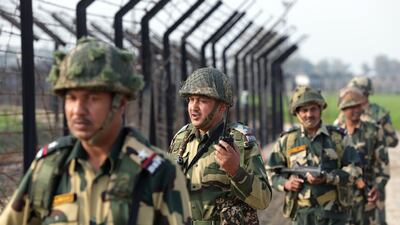In the early hours of Friday morning, India's foreign minister Sushma Swaraj landed in Abu Dhabi as the guest of honour at the 2019 plenary session of the Organisation of Islamic Cooperation (OIC). Unfortunately, this visit took place against the backdrop of a growing crisis between India and Pakistan, following a rare dogfight in the skies over the contested territory of Kashmir, in which both nations lost fighter aircraft. Pakistan boycotted the event over India's participation, while the UAE welcomed it. In some ways, this represented a clear role reversal from the first OIC meeting in Morocco in 1969, to which New Delhi was invited and then, on the insistence of Islamabad, promptly disinvited.
On February 26, Indian Air Force Mirage 2000 jets struck targets in Pakistan's Khyber-Pakhtunkwa region, targeting what New Delhi claims were training facilities run by the terrorist group Jaish-e-Mohammed (JeM). Further escalations were expected and Indian fighter aircraft exchanged fire with their Pakistani counterpart on the 27th. While Pakistan claimed that it had struck targets inside Indian territory, India has stated that the aircraft were forced to withdraw. In the aerial skirmish, the Indian MiG 21 pilot Wing Commander Abhinandan Varthaman was captured after his plane was downed in Pakistan-administered Kashmir, bringing the two nuclear-armed neighbours to the brink of a full-blown, official conflict. As international diplomacy came into play – with the US, UAE and Saudi Arabia all playing significant roles – Prime Minister Imran Khan of Pakistan announced the release of the pilot as a "peace gesture", which, in turn, forced India to de-escalate.
The Indian strikes were an unprecedented reaction to an attack, claimed by JeM, against a convoy of India’s Central Reserve Police Force (CRPF) a few days earlier, which killed 44 in the town of Pulwama, in Indian-administered Kashmir. The current rising tensions can be traced back to 2016, when two significant terror attacks were carried out against an Indian Army brigade headquarters in Uri, Indian-administered Kashmir, and Pathankot military base in Punjab. Despite a “surgical strike” conducted by India across the Line of Control, militancy in Kashmir, specifically the southern parts, was seen as being at unprecedented levels.
India's February 26 attack can be seen as more of a signalling of intent than a counter-terror operation. Despite India declaring that extensive damage has been done to JeM's ecosystem, the main purpose of the operation was to showcase New Delhi's will and ability to target terror bases well within sovereign Pakistani territory. While the Indian military's claims are still being debated, the message is unambiguous. Simply put, cross-border air strikes against terror targets are a real and present part of India's strategy. Such strikes were proposed to previous governments, including during the Kargil war of 1999. However, in an effort to keep the conflict under control, Atal Bihari Vajpayee – prime minister at that time – chose not to avail himself of that option.
India’s actions also have a certain sense of political expediency. In roughly 40 days’ time, India’s Prime Minister Narendra Modi is set to lead his Bharatiya Janata Party (BJP) into the world’s biggest democratic election process. The strikes against JeM will appeal to his base and build confidence in him as a prime minister who is ready to disrupt the status-quo and take decisive action against threats to his nation. The narrative has shifted from tackling terror head-on in Indian-administered Kashmir to tackling it on the other side of the border. The loss of the MiG 21 and that capture of Wing Commander Abhinandan have, however, have had a negative effect on the optics of these actions. While the Indian Air Force would have anticipated such an eventuality, it seems the nation’s leadership did not. Despite this, the narrative of giving the military a “free hand”, which Mr Modi reiterated in the hours after Pulwama, will still enhance his voter appeal. On the other side, a similar situation was faced by Mr Khan, who, for the sake of appearances to Pakistani citizens, had to retaliate. Mr Khan’s actions were possibly even more important to his position, given that the Pakistani military is widely considered to run the country, rather than the other way around.
The US scholar Stephen F Cohen once said that Pakistan negotiates with the world with a gun to its own head, threatening suicide if its demands are not met. However, this time, Islamabad noticed that it had next to no international support, and that India's actions had not been explicitly condemned. Even China, Pakistan's all-weather ally and bailout system, released only a formal statement asking New Delhi to respect the sovereignty of Pakistan. In the end, the Indian strikes and the events that have unfolded since have irrevocably altered South Asia's security paradigm and created a whole new normal for the region.
Kabir Taneja is associate fellow, Strategic Studies Programme, Observer Research Foundation, New Delhi

